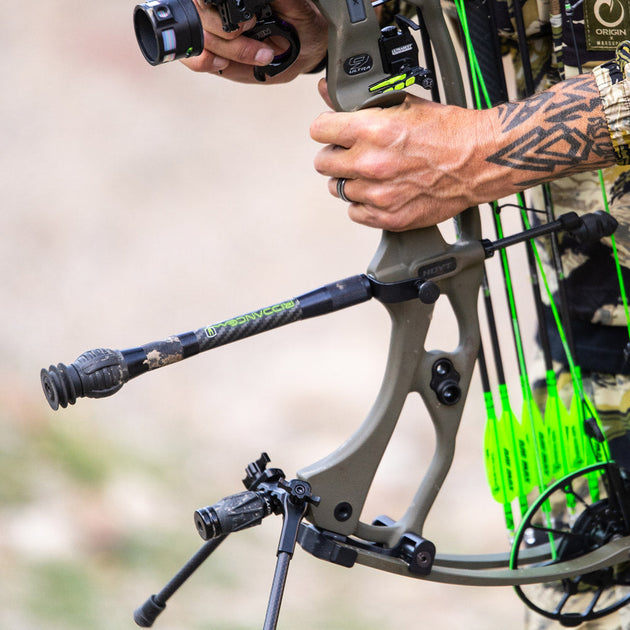Open Your Archery Potential with the Right Compound Bow Stabilizer
Open Your Archery Potential with the Right Compound Bow Stabilizer
Blog Article
Maximizing Your Archery Performance With the Right Compound Bow Stabilizer: an Extensive Review
One often-overlooked yet important part in improving precision is the compound bow stabilizer. By recognizing the nuances of choose and maximizing a substance bow stabilizer, archers can adjust their tools to boost their capturing experience to new levels of efficiency and control.
Value of Bow Stabilizers in Archery

In addition, bow stabilizers aid in balancing the weight circulation of the bow, which can improve the archer's stability while shooting and intending. By adding weight to the front of the bow, stabilizers can minimize the quantity of torque experienced upon launch, leading to a smoother and a lot more regulated shot - compound bow stabilizer. This weight distribution also helps in holding the bow consistent for a longer duration, allowing the archer to aim much more properly
Sorts Of Substance Bow Stabilizers
When taking into consideration the various sorts of compound bow stabilizers offered, it is necessary to understand their distinct functions and functions to figure out the most suitable choice for making best use of archery efficiency. The most usual types of compound bow stabilizers consist of sidebar stabilizers, front stabilizers, and back stabilizers. Sidebar stabilizers attach to the sides of the riser and help in stabilizing the bow throughout the intending process. Front stabilizers, additionally referred to as long poles, are attached to the front of the riser and aid in soaking up and minimizing any resonances brought on by the launch of the arrowhead, thus boosting accuracy. Back stabilizers, additionally called rear stabilizers, are placed to the back of the bow and aid in counteracting the weight of various other devices, causing enhanced security and constant aiming. In addition, some stabilizers include adjustable weights that enable archers to tweak the equilibrium and feel of their bows according to their preferences, making them flexible options for archery lovers of all degrees.
Factors to Think About When Selecting
In evaluating compound bow stabilizers, comprehending the distinctive features and features of each kind is vital for making an informed decision on one of the most appropriate choice to enhance archery performance. When selecting a stabilizer, one must take into consideration the weight of the stabilizer itself. While a larger stabilizer can supply even more security by decreasing the bow's activity, it may also create exhaustion throughout long Continue shooting sessions. Equilibrium is one more essential element to ponder. The stabilizer's size and style substantially affect the bow's balance, influencing the shooter's capability to hold stable objective. In addition, the material of the stabilizer can influence its performance. Carbon fiber stabilizers are lightweight and take in vibrations well, enhancing accuracy. The number and adjustability of dampeners on the stabilizer can fine-tune its performance by minimizing sound and shock upon release. By very carefully examining these elements, archers can pick a compound bow stabilizer that lines up with their shooting design and maximizes their total performance on the archery variety.
Installation and Adjustment Tips
For optimum efficiency and precision in archery, understanding the installment and change of your bow stabilizer is necessary. Proper setup starts with connecting the stabilizer to the bow's riser, ensuring it is strongly protected.
When readjusting the stabilizer, begin with tiny incremental changes instead than drastic adjustments. Pay focus to how the bow responds to modifications in stabilizer setups and make modifications accordingly. Consistently examine the stabilizer's rigidity and overall problem to guarantee it proceeds to work ideally.
Upkeep and Treatment Standards

When not in use,It is likewise necessary to keep your bow with the stabilizer in a secure and safe and secure place. compound bow stabilizer. Avoid leaving it in extreme temperatures or subjected to direct sunlight for prolonged periods, as this can cause damages to the stabilizer. Regularly check the stabilizer's placement to guarantee it is still appropriately positioned on your bow. Following these upkeep and treatment guidelines will assist you get one of the most out of your bow stabilizer and improve your general archery performance.
Final Thought
Finally, selecting the ideal substance bow stabilizer is essential for maximizing archery performance. Comprehending the importance, types, elements to take into consideration, installment and modification suggestions, as well as maintenance and care guidelines can substantially influence one's precision and consistency in capturing. By selecting a stabilizer that matches private demands and preferences, archers can boost their total efficiency and attain much better results on the range or in competitors.
Bow stabilizers play a vital role in improving an archer's precision and consistency by decreasing vibrations and supporting the bow throughout the release of an arrowhead - compound bow stabilizer.Furthermore, bow stabilizers assist in balancing the weight circulation of the Learn More Here bow, which can enhance the archer's security while intending and shooting. The most typical types of substance bow stabilizers consist of sidebar stabilizers, front stabilizers, and back stabilizers. Back stabilizers, likewise called rear stabilizers, are installed to the back of the bow and assist in counteracting the weight of various other accessories, resulting in improved security and constant aiming. When picking a stabilizer, one need to take into consideration the weight of the stabilizer itself
Report this page